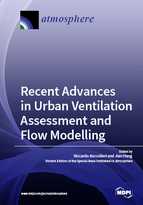Recent Advances in Urban Ventilation Assessment and Flow Modelling
A special issue of Atmosphere (ISSN 2073-4433). This special issue belongs to the section "Atmospheric Techniques, Instruments, and Modeling".
Deadline for manuscript submissions: closed (31 May 2018) | Viewed by 137835
Special Issue Editors
Interests: urban air quality and microclimate; experimental and computational fluid dynamics; turbulence and pollutant dispersion; urban ventilation and vegetation
Special Issues, Collections and Topics in MDPI journals
Interests: urban ventilation; urban heat island; urban turbulence; urban pollutant dispersion
Special Issues, Collections and Topics in MDPI journals
Special Issue Information
Dear Colleagues,
We invite researchers to contribute original research articles, as well as review articles, dealing with all aspects of ventilation in urban areas. These contributions include recent experimental and modeling works, techniques and developments tailored to the assessment of urban ventilation and flow and pollutant dispersion in cities. We are also interested in reviews with possible future lines of investigations. Topics of interest include, but are not limited to:
-
ventilation efficiency and application/development of ventilation indices;
-
relation between indoor and outdoor ventilation;
-
effects of urban morphology and obstacles on ventilation;
-
data (meteorological and air quality) from new field campaigns in cities and wind tunnel experiments for the estimation of ventilation indices;
-
experimental and modeling application studies to real cities with attention to high density cities and high-rise buildings;
-
mitigation strategies of poor ventilation conditions and urban air pollution.
Dr. Riccardo Buccolieri
Dr. JianHang
Guest Editors
Manuscript Submission Information
Manuscripts should be submitted online at www.mdpi.com by registering and logging in to this website. Once you are registered, click here to go to the submission form. Manuscripts can be submitted until the deadline. All submissions that pass pre-check are peer-reviewed. Accepted papers will be published continuously in the journal (as soon as accepted) and will be listed together on the special issue website. Research articles, review articles as well as short communications are invited. For planned papers, a title and short abstract (about 100 words) can be sent to the Editorial Office for announcement on this website.
Submitted manuscripts should not have been published previously, nor be under consideration for publication elsewhere (except conference proceedings papers). All manuscripts are thoroughly refereed through a single-blind peer-review process. A guide for authors and other relevant information for submission of manuscripts is available on the Instructions for Authors page. Atmosphere is an international peer-reviewed open access monthly journal published by MDPI.
Please visit the Instructions for Authors page before submitting a manuscript. The Article Processing Charge (APC) for publication in this open access journal is 2400 CHF (Swiss Francs). Submitted papers should be well formatted and use good English. Authors may use MDPI's English editing service prior to publication or during author revisions.
Keywords
- Ventilation efficiency
- Urban morphology and obstacles
- Field and wind tunnel experiments
- Flow modelling
- Mitigation strategies







